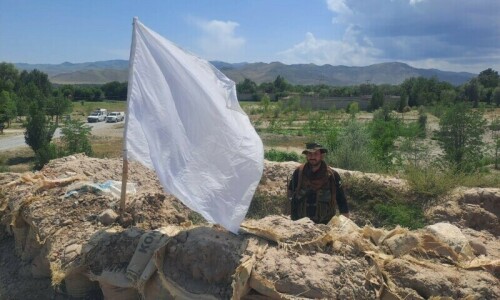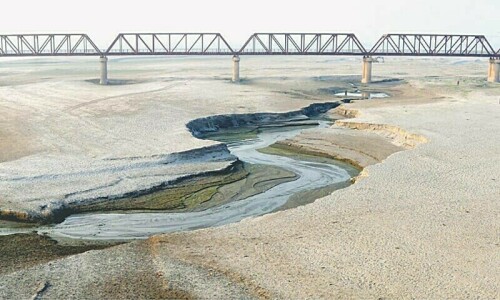KARACHI: The central bank has lowered its projected GDP growth from the previously announced range of 3-4 per cent for the current fiscal year, citing flood-induced destruction and the stabilisation policy as major factors in its flagship economic health report released on Wednesday.
However, in its Annual Report on the State of Pakistan’s Economy, which mostly discussed the previous financial year that ended on June 30, the State Bank of Pakistan (SBP) said economic growth was stronger than expected in the 2021-22 fiscal year as real GDP increased by 6pc compared to 5.7pc a year ago.
The primary drivers of this growth were a broad-based expansion in large-scale manufacturing (LSM) and improved agricultural output, the report said.
“A combination of adverse global and domestic developments led to the re-emergence of macroeconomic imbalances during FY22,” it said.
Cuts FY23 outlook after considering flood-induced destruction, policy focus on stabilisation
The SBP said that the economy was already in a stabilisation phase when widespread flooding hit a large part of the country at the start of the current fiscal year.
It said the flooding was likely to impinge on the country’s real economic activity through various channels, fearing that losses in agriculture emerging from the damages to crops and livestock were likely to transmit to the rest of the economy through various backward and forward linkages.
The large-scale destruction of infrastructure in the affected provinces might also undermine the country’s growth prospects during the year, the bank said.
The SBP avoided providing any range for the growth rate of the current financial year apparently due to the worsening economic situation. Industries have either shut down or drastically cut their production due to high inflation and the unavailability of gas and electricity.
One major reason is the cork put by the SBP on the opening of letters of credit (LCs) for imports in an attempt to save dollars.
The All-Pakistan Textile Mills Association has threatened to announce lay-offs within days if the gas supply is not restored and LCs are not opened.
The textile industry claims that up to 500,000 people, who were associated with the sector directly or indirectly, have lost their jobs. No official data is available in this regard.
International credit rating agencies have slashed the credit rating of Pakistan and predicted an economic growth rate of around 2pc for the current fiscal year.
The SBP report said that several corrective and other measures were likely to slow the momentum of economic activity during FY23, including a hike of 675 basis points in the policy rate, demand management measures announced in the previous fiscal year, and the government’s decision to unwind the fiscal package for fuel and electricity subsidies towards the end of FY22.
The report noted that the expansionary fiscal stance in FY22, an upsurge in global commodity prices, and the fallout of the Russia-Ukraine conflict led to a marked deterioration in the current account deficit.
In addition, the delay in the resumption of the IMF loan programme and political instability exacerbated the country’s vulnerability through the depletion of foreign exchange reserves.
The resulting rupee depreciation “amplified inflationary pressures by magnifying the effect of global price increase”, the SBP report said.
It said the experience from FY22 brought to the fore once again the need to address the country’s structural weaknesses, such as a narrow base of foreign exchange earnings and meagre inflows of foreign investment.
“A concerted approach is required to encourage increased localisation of the manufacturing base, along with the lowering of energy intensity of the economy by ensuring energy efficiency and conservation,” the report said.
Moreover, amid the growing issues related to climate change and inadequate food security situation, there is an urgent need to formulate a well-thought-out strategy to meet these challenges, it said.
It stressed that priority should be given to producing new varieties of seeds that are suitable to varying weather conditions and to devise a framework that emphasises water management strategies to increase agricultural productivity.
“The losses to agriculture produce induced by the recent floods is likely to step up the import of agriculture commodities, particularly cotton,” the report said.
It said the government has targeted to reduce the fiscal deficit to 4.9pc of GDP in FY23 from 7.9pc in FY22. “This outcome would be achieved through both revenue and expenditure measures,” it said.
In fact, the fiscal deficit exceeded in the first quarter of FY23, annoying the IMF, which demanded more measures to reduce the gap.
Published in Dawn, December 22nd, 2022














































